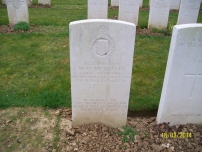| First Name: | William Henry | Last Name: | METCALFE | |
|---|---|---|---|---|
| Date of Death: | 11/04/1917 | Lived/Born In: | Wanstead | |
| Rank: | Private | Unit: | Machine Gun Corps (Cavalry) 8th Squadron | |
| Memorial Site: | ||||
Current Information:Enlisted-Colchester Tilloy British Cemetery, Tilloy-les-Mofflaines, France
The Battle of Arras was a series of offensives by the British Army between 9th April 1917 and 16th May 1917. It had been planned in conjunction with the French who would attack in Artois and between them the Allies would force the Germans out of the large salient they had held since the line of trenches was first established. But the Germans had spoiled this plan by falling back to the new and very strong Hindenburg Line in January 1917 and the salient no longer existed. For the want of an alternative plan the attack went ahead anyway. It all started well for the British who made substantial gains on the first two days but then the offensive ground to a halt and by the end their losses amounted to over 150,000. The First Battle of the Scarpe (9-14 April) Substantial gains were made all along the front during the first two days of the battle but the hoped for continuation of this advance on the third day, 11th April, did not happen. There were three main reasons for this: the logistical nightmare of bringing up all the supplies needed over battle-torn ground, the extra new troops that the Germans committed to the battle and the formidable defence system that was the Hindenburg Line, which although breached in places was a defence in depth. But there was one success on 11th April and that was the capture of the village of Monchy-le-Preux. This was achieved by 111 Brigade of 37th Division with the assistance of four tanks all of which were put out of action but not before having rendered a very useful service to the infantry. Nevertheless 111 Brigade had suffered heavy losses and if Monchy-le-Preux was to be held and cleared of any lingering Germans, reinforcements were needed. This came in the shape of 3rd Cavalry Division. At 8.30am three squadrons of 3rd Dragoon Guards, 6 Cavalry Brigade, and one each from the Essex Yeomanry and 10th Hussars, both 8 Cavalry Brigade, galloped forward, the rest of the three regiments following behind. The 8th Squadron of the Machine Gun Corps (Cavalry) were also involved. Some reached the Monchy-Le Bergère-Wancourt road under heavy machine-gun fire from Guémappe direction which prevented further progress. Here they dismounted and filled a gap between 111 and 112 Brigades. Others came under heavy fire from the left and to avoid it they wheeled to the right and galloped into the north-west corner of Monchy-le-Preux. Some had turned south to avoid this same fire and also entered the village where they met at the central square. Their attempts to pursue the enemy eastwards towards Pelves, Pelves Mill and Roeux failed when they were driven back by intense machine-gun fire. The enemy now opened up on the village with every gun they could muster, a concentration of fire that few had experienced before. High Explosive shells landing on the paved streets caused heavy casualties especially among the horses. With the infantry shattered, the defence of the village rested with the cavalry. The horses were sent back and the cavalry men became infantry men and kept the enemy counter attacks at bay for the rest of the day, through blinding snow storms, until relieved that evening. There were many casualties among the cavalry in Monchy-le-Preux on 11th April and included among them was William Metcalfe. |
||||
| « Back to Search Results | ||||
| If you think any of the information shown here is incorrect, Click Here to submit your amends and comments | ||||




